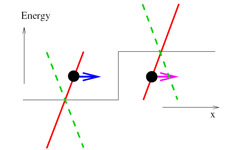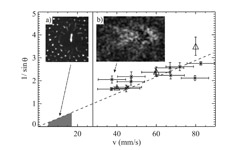Accueil
How massless electrons tunnel through graphene (Vol. 43 No. 2)
 Klein tunnelling in one dimension. An electron incident from the left on a sharp potential step (the blue arrow indicates its direction of motion)
Klein tunnelling in one dimension. An electron incident from the left on a sharp potential step (the blue arrow indicates its direction of motion)
Electrons moving in graphene behave in an unusual way, as demonstrated by 2010 Nobel Prize laureates for physics A. Geim and K. Novoselov, who performed transport experiments on this one-carbon-atom-thick material. The present review explores the theoretical and experimental results to date of electrons tunnelling through energy barriers in graphene.
What could partly explain graphene's properties is that electrons travelling inside the material behave as if they were massless. Their behaviour is described by the so-called Dirac equation, which is normally used for high-energy particles such as neutrinos in vacuum moving at a velocity 300 times greater than that of electrons, nearing the speed of light.
In this review, the authors focus on the tunnelling effect occurring when Dirac electrons found in graphene are transmitted through different types of energy barriers. Contrary to the laws of classical mechanics, which govern larger scale particles that cannot cross energy barriers, electron tunnelling is possible in quantum mechanics - though only under restricted conditions, depending on the width and energy height of the barrier.
However, the Dirac electrons found in graphene can tunnel through energy barriers regardless of their width and energy height; a phenomenon called Klein tunnelling, described theoretically for 3D massive Dirac electrons by the Swedish physicist Oskar Klein in 1929. Graphene was the first material in which Klein tunnelling was observed experimentally, as massive Dirac electrons required energy barriers too large to be observed.
Klein tunnelling in graphene: optics with massless electrons
P.E. Allain and J.N. Fuchs, Eur. Phys. J. B 83, 301 (2011)
[Abstract]
Speed of sound in a complex plasma under microgravity (Vol. 43 No. 2)
 Mach cone relation linking the Mach cone angle θ with the probe particle speed v in experiments (crosses) and simulation (triangles). (a) Zoom showing the subsonic probe particle. (b) Smoothed difference between two successive frames, highlighting the Mach cone.
Mach cone relation linking the Mach cone angle θ with the probe particle speed v in experiments (crosses) and simulation (triangles). (a) Zoom showing the subsonic probe particle. (b) Smoothed difference between two successive frames, highlighting the Mach cone.
Complex plasma experiments under microgravity conditions in the International Space Station ISS, complementing research on Earth, are very important for the progress in this field. Complex plasmas consist of micrometre-sized highly charged particles ("microparticles") embedded in an ionized gas ("plasma"). The microparticle ensemble resembles a classical system of interacting atoms. This system can form all of the classic phases, i.e., crystalline, liquid and gaseous. It can also support the propagation of sound waves, solitons and shock waves.
In experiments carried out on Earth, gravity pulls the microparticles downwards resulting in two-dimensional structures. Under microgravity conditions it is possible to investigate big, three-dimensional systems. The PK-3 Plus laboratory provides ideal conditions for such experiments. It is installed in the Russian segment of the ISS and has been used repeatedly over the last 6 years.
We performed experiments to measure the speed of sound during two missions with cosmonauts Volkov and Skvortsov. In Figs. (a) and (b) we show how a bigger "probe" particle penetrated a cloud of smaller microparticles. At a speed several times faster than the speed of sound it excited a Mach cone. A double cone structure is discernible in this "atomistic" system. While moving through the cloud, the probe particle is decelerated to subsonic speeds. By measuring the Mach cone angle at several probe particle velocities, we determined the Mach relation. This allows us to directly measure the speed of sound and to infer the microparticle charge. In addition, the experimental results agree well with a 3D molecular-dynamics simulation, demonstrating in particular a double Mach cone structure.
Direct measurement of the speed of sound in a complex plasma under microgravity conditions
M. Schwabe, K. Jiang, S. Zhdanov, T. Hagl, P. Huber, A. V. Ivlev, A. M. Lipaev, V. I. Molotkov, V. N. Naumkin, K. R. Sütterlin, H. M. Thomas, V. E. Fortov, G. E. Morfill, A. Skvortsov and S. Volkov, EPL, 96, 55001 (2011)
[Abstract]
Tailoring AlGaInAs quantum dot solar cells (Vol. 43 No. 2)
 External quantum efficiency of various solar cell devices: 1) Bulk reference; 2) QD-solar cell without delta-doping; 3) QD-solar cell with delta-doping; 4) Increased number of QD layers; 5) QD-solar cell with delta-doping but reversed QD-arrangement. Inset: Atomic force microscopy image of uncapped AlGaInAs QDs with a remarkably high areal density of 5x1010 cm-2.
External quantum efficiency of various solar cell devices: 1) Bulk reference; 2) QD-solar cell without delta-doping; 3) QD-solar cell with delta-doping; 4) Increased number of QD layers; 5) QD-solar cell with delta-doping but reversed QD-arrangement. Inset: Atomic force microscopy image of uncapped AlGaInAs QDs with a remarkably high areal density of 5x1010 cm-2.
One of the most important challenges in seeking for competitive energy resources is to increase the efficiency of solar cells. The intermediate band solar cell promises highest efficiencies in a single gap device, since it allows for the absorption of below-bandgap photons via a subband located within the host material's bandgap. In order to generate an isolated subband, electronically coupled stacks of quantum dots (QDs) have been proposed. The built-in potential in the intrinsic region of the solar cell however unavoidably lifts the approximate degeneracy between the QD electron eigenenergies. Hence, the wave functions in adjacent layers would be electronically decoupled, resulting in carrier localization.
To avoid this effect and facilitate the formation of a QD-subband, the present work focuses on the integration of tailored quaternary AlGaInAs QDs. it deals with three major goals in quantum dot solar cell research: Increasing QD absorption by the fabrication of high areal density QDs, engineering the QD's bandgap to tailor their absorption range, and preserving the possibility to maintain an intermediate band despite the built-in potential being present in solar cell p-n-junctions. By a suitable choice of QD composition, shape and barrier thickness they show by simulations routes toward QD-IBSC designs, whereas they experimentally demonstrate a widened spectral absorption range.
AlGaInAs quantum dot solar cells: tailoring quantum dots for intermediate band formation
C. Schneider, S. Kremling, N. V. Tarakina, T. Braun, M. Adams, M. Lermer, S. Reitzenstein, L. Worschech, M. Kamp, S. Höfling and A. Forchel, Semicond. Sci. Technol. 27 032002 (2012)
[Abstract]
Largest ever gas mix caught in ultra-freeze trap (Vol. 43 No. 2)
 Absorption images of the MOTs and the doubly-integrated optical density profile
Absorption images of the MOTs and the doubly-integrated optical density profile  , recorded with a resonant imaging beam
, recorded with a resonant imaging beam
The article summarised here leads to a better understanding of subatomic particles using a new cold-atom setup. The work make it easier to study atomic or subatomic-scale properties of the building blocks of matter (which also include protons, neutrons and electrons) known as fermions by slowing down the movement of a large quantity of gaseous atoms at ultra-low temperature.
Thanks to the laser cooling method for which Claude Cohen-Tannoudji, Steven Chu and William D. Phillips received the Nobel Prize in 1997, the authors succeeded in creating the largest Lithium 6 (6Li) and Potassium 40 (40K) gas mixture to date. The experimental approach involved confining gaseous atoms under ultra-high vacuum using electromagnetic forces, in an ultra-freeze trap of sorts.
This trap enabled them to load twice as many atoms than previous attempts at studying such gas mixtures, reaching a total on the order of a few billion atoms under study at a temperature of only a few hundred microKelvins (corresponding to a temperature near the absolute zero of roughly -273 °C).
Given that the results of this study significantly increased the number of gaseous atoms under study, it will facilitate future simulation of subatomic-scale phenomena in gases. In particular, it will enable future experiments in which the gas mixture is brought to a so-called degenerate state characterised by particles of different species with very strong interactions. Following international efforts to produce the conditions to study subatomic-scale properties of matter under the quantum simulation program, this could ultimately help scientists to understand quantum mechanical phenomena occurring in neutron stars and so-called many-body problems such as high-temperature superconductivity.
Large atom number dual-species magneto-optical trap for fermionic 6Li and 40K atoms
A. Ridinger, S. Chaudhuri, T. Salez, U. Eismann, D. Rio Fernandes, D. Wilkowski, F. Chevy and C. Salomon, Eur. Phys. J. D, 65, 1-2. (2011) - cold quantum matter special issue.
[Abstract]







